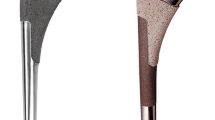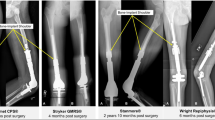Abstract
Background
Fixation of cementless orthopaedic implants is not always achieved, particularly in challenging scenarios such as revision surgery, trauma, and tumor reconstruction. An adjunct therapy for improving implant fixation would improve the reliability and durability of certain reconstructive procedures.
Questions/purposes
The purpose of this study was to determine the effect of local elution of the bisphosphonate alendronic acid on bone formation around porous titanium implants in an animal model.
Methods
Porous-coated cylindrical rods were coated with either 0.2 mg or 1.0 mg alendronic acid before bilateral surgical implantation into the femoral intramedullary canals of 10 experimental dogs. Twelve weeks after surgery, the femora were harvested and scanned with micro-CT to quantify the percentage volume of bone within the immediate periimplant space. Four femora from two dogs were also processed for undecalcified thin-section histology and analysis with backscattered scanning electron microscopy. Three histologic sections from each of these four femora were anatomically matched with transverse micro-CT sections to enable direct comparison of the area fraction of bone within the periimplant space.
Results
Compared with paired controls, micro-CT analysis showed that local elution of alendronic acid increased periimplant bone at both doses of 0.2 mg (+52%, p = 0.01) and 1.0 mg (+152%, p = 0.004) with 1.0 mg resulting in a 2.9-fold greater mean relative increase compared with 0.2 mg (p = 0.002). Micro-CT measurements of periimplant bone formation correlated very strongly with the backscattered scanning electron microscopy measurements (R = 0.965, p < 0.001).
Conclusions
Local elution of alendronic acid causes a dose-dependent net increase in periimplant bone formation in an animal model.
Clinical Relevance
This concept has potential to improve the biologic fixation of porous reconstructive implants.
Level of Evidence
Level II, therapeutic study. See Guidelines for Authors for a complete description of levels of evidence.






Similar content being viewed by others
References
Arabmotlagh M, Pilz M, Warzecha J, Rauschmann M. Changes of femoral periprosthetic bone mineral density 6 years after treatment with alendronate following total hip arthroplasty. J Orthop Res. 2009;27:183–188.
Bhandari M, Bajammal S, Guyatt GH, Griffith L, Busse JW, Schünemann H, Einhorn TA. . Effect of bisphosphonates on periprosthetic bone mineral density after total joint arthroplasty. A meta-analysis. J Bone Joint Surg Am. 2005;87:293–301.
Bobyn JD, Hacking SA, Krygier JJ, Harvey EJ, Little DG, Tanzer M. Zoledronic acid causes enhancement of bone growth into porous implants. J Bone Joint Surg Br. 2005;87:416–420.
Bobyn JD, McKenzie K, Karabasz D, Krygier JJ, Tanzer M. Locally delivered bisphosphonate for enhancement of bone formation and implant fixation. J Bone Joint Surg. 2009;91(Suppl 6):23–31.
Cook RE, Jenkins PJ, Walmsley PJ, Patton JT, Robinson CM. Risk factors for periprosthetic fractures of the hip: a survivorship analysis. Clin Orthop Relat Res. 2008;466:1652–1656.
Friedl G, Radl R, Stihsen C, Rehak P, Aigner R, Windhager R. The effect of a single infusion of zoledronic acid on early implant migration in total hip arthroplasty. A randomized, double-blind, controlled trial. J Bone Joint Surg Am. 2009;91:274–281.
Gao Y, Zou S, Liu X, Bao C, Hu J. The effect of surface immobilized bisphosphonates on the fixation of hydroxyapatite-coated titanium implants in ovariectomized rats. Biomaterials. 2009;30:1790–1796.
Garbuz DS, Hu Y, Kim WY, Duan K, Masri BA, Oxland TR, Burt H, Wang R, Duncan CP. Enhanced gap filling and osteoconduction associated with alendronate-calcium phosphate-coated porous tantalum. J Bone Joint Surg Am. 2008;90:1090–1100.
Garcia-Moreno C, Serrano S, Nacher M, Farré M, Díez A, Mariñoso ML, Carbonell J, Mellibovsky L, Nogués X, Ballester J, Aubía J. Effect of alendronate on cultured normal human osteoblasts. Bone. 1998;22:233–239.
Goodship AE, Blunn GW, Green J, Coathup MJ. Prevention of strain-induced osteopenia in aseptic loosening of hip prostheses using perioperative bisphosphonate. J Orthop Res. 2008;26:693–703.
Hilding M, Aspenberg P. Local preoperative treatment with a bisphosphonate improves the fixation of total knee prostheses. Acta Orthop. 2007;78:795–799.
Jakobsen T, Baas J, Kold S, Bechtold JE, Elmengaard B, Søballe K. Local bisphosphonate treatment increases fixation of hydroxyapatite-coated implants inserted with bone compaction. J Orthop Res. 2009;27:189–194.
Lindahl H. Epidemiology of periprosthetic femur fracture around a total hip arthroplasty. Injury. 2007;38:651–654.
Papapetrou PD. Bisphosphonate-associated adverse events. Hormones. 2009;8:96–110.
Peter B, Gauthier O, Laib S, Bujoli B, Guicheux J, Janvier P, van Lenthe GH, Müller R, Zambelli PY, Bouler JM, Pioletti DP. Local delivery of bisphosphonate from coated orthopedic implants increases implant mechanical stability in osteoporotic rats. J Biomed Mater Res A. 2006;76:133–143.
Peter B, Pioletti DP, Laib S, Bujoli B, Pilet P, Janvier P, Guicheux J, Zambelli PY, Bouler JM, Gauthier O. Calcium phosphate drug delivery system: influence of local zoledronate release on bone implant osteointegration. Bone. 2005;36:52–60.
Prieto-Alhambra B, Javaid MK, Judge A, Murray D, Carr A, Cooper C, Arden NK. Association between bisphosphonate use and implant survival after primary total arthroplasty of the knee or hip: population based retrospective cohort study. BMJ. 2011;343:1–9.
Tanzer M, Karabasz D, Krygier JJ, Cohen R, Bobyn JD. Bone augmentation around and within porous implants by local bisphosphonate elution. Clin Orthop Relat Res. 2005;441:30–39.
Tengvall P, Skoglund B, Askendal A, Aspenberg P. Surface immobilized bisphosphonate improves stainless-steel screw fixation in rats. Biomaterials. 2004;25:2133–2138.
Yoshinari M, Oda Y, Inoue T, Matsuzaka K, Shimono M. Bone response to calcium phosphate-coated and bisphosphonate-immobilized titanium implants. Biomaterials. 2002;23:2879–2885.
Acknowledgments
We thank Pipeline Biotechnology for providing the implants.
Author information
Authors and Affiliations
Corresponding author
Additional information
The institution of one or more of the authors (JDB, MT) has received, during the study period, funding from the Canadian Institutes of Health Research and Pipeline Biotechnology. Two of the authors (JDB, MT) certify that they each received payments or benefits, during the study period, an amount of USD 10,000 to USD 100,000 from Pipeline Biotechnology (Cedar Knolls, NJ, USA).
All ICMJE Conflict of Interest Forms for authors and Clinical Orthopaedics and Related Research editors and board members are on file with the publication and can be viewed on request.
Clinical Orthopaedics and Related Research neither advocates nor endorses the use of any treatment, drug, or device. Readers are encouraged to always seek additional information, including FDA-approval status, of any drug or device prior to clinical use.
Each author certifies that his or her institution approved the animal protocol for this investigation and that all investigations were conducted in conformity with ethical principles of research.
About this article
Cite this article
Bobyn, J.D., Thompson, R., Lim, L. et al. Local Alendronic Acid Elution Increases Net Periimplant Bone Formation: A Micro-CT Analysis. Clin Orthop Relat Res 472, 687–694 (2014). https://doi.org/10.1007/s11999-013-3120-6
Published:
Issue Date:
DOI: https://doi.org/10.1007/s11999-013-3120-6




